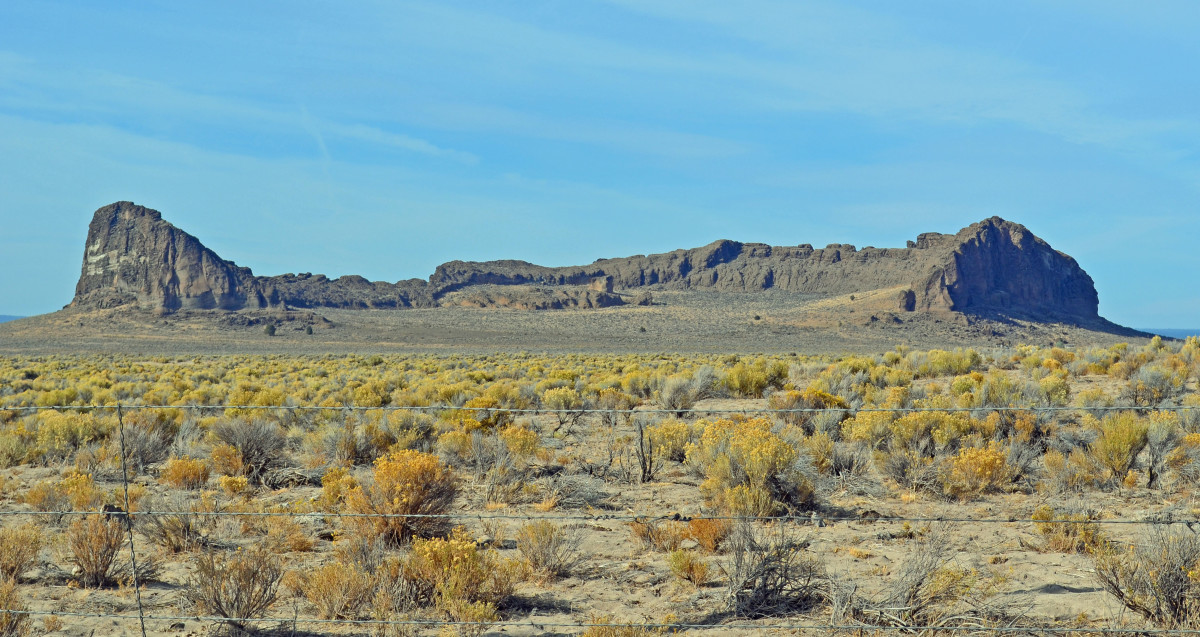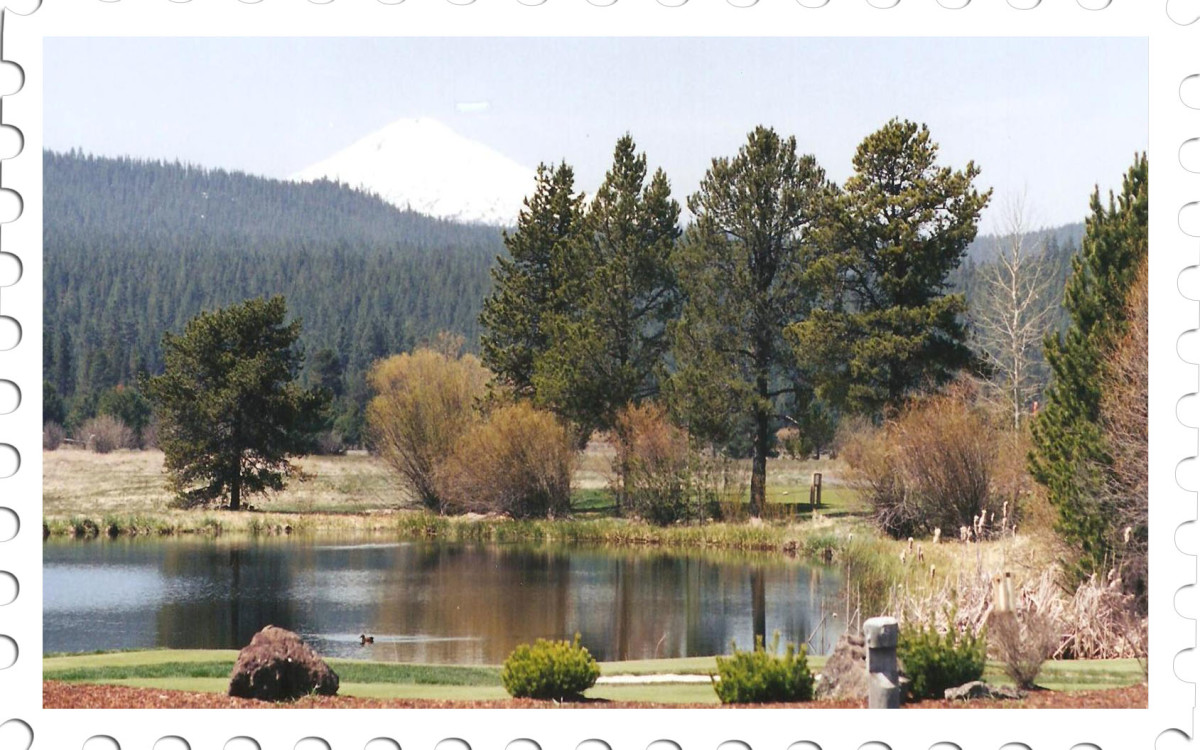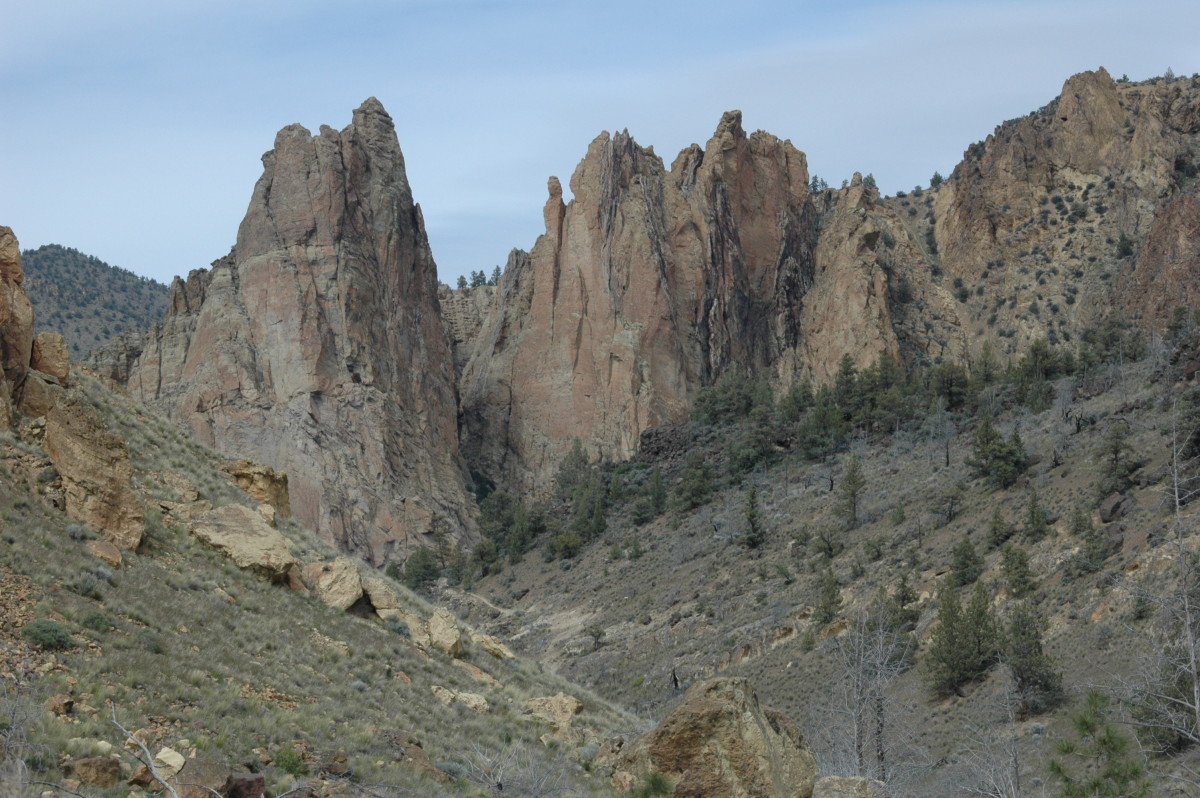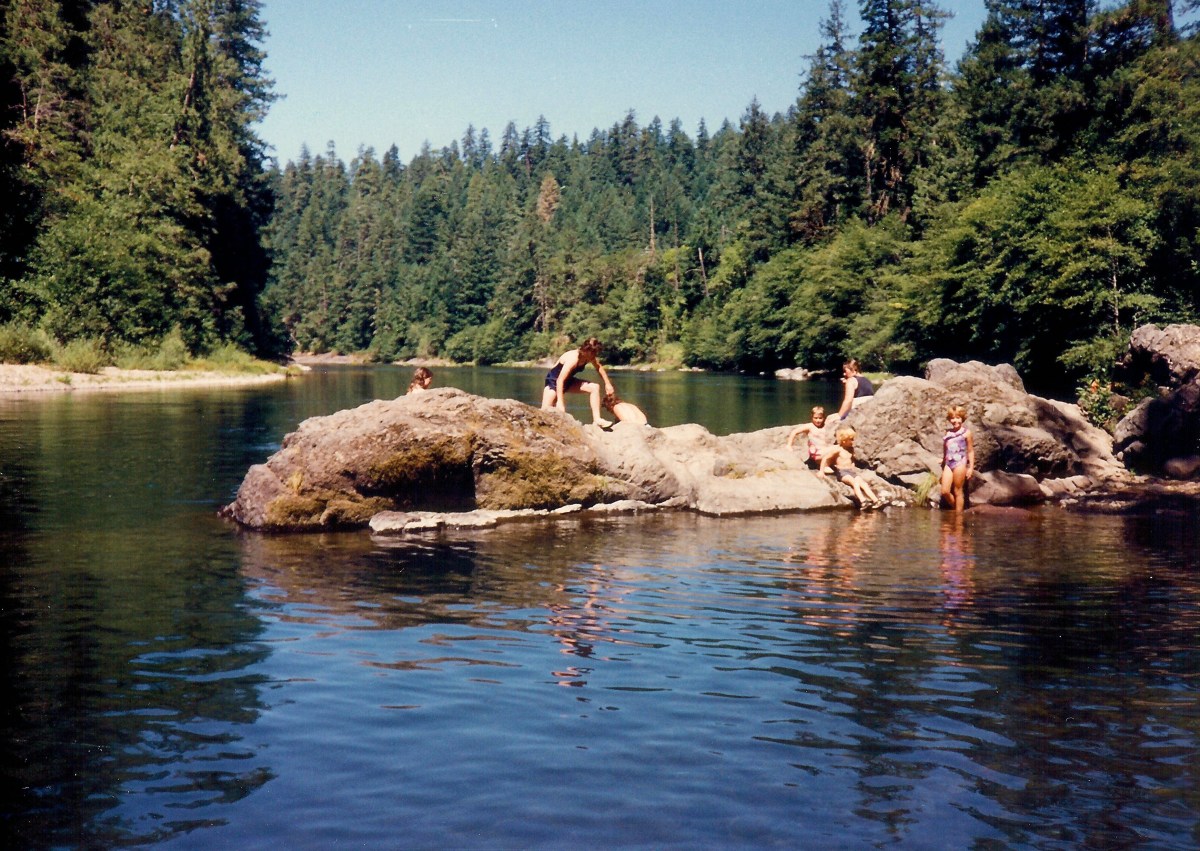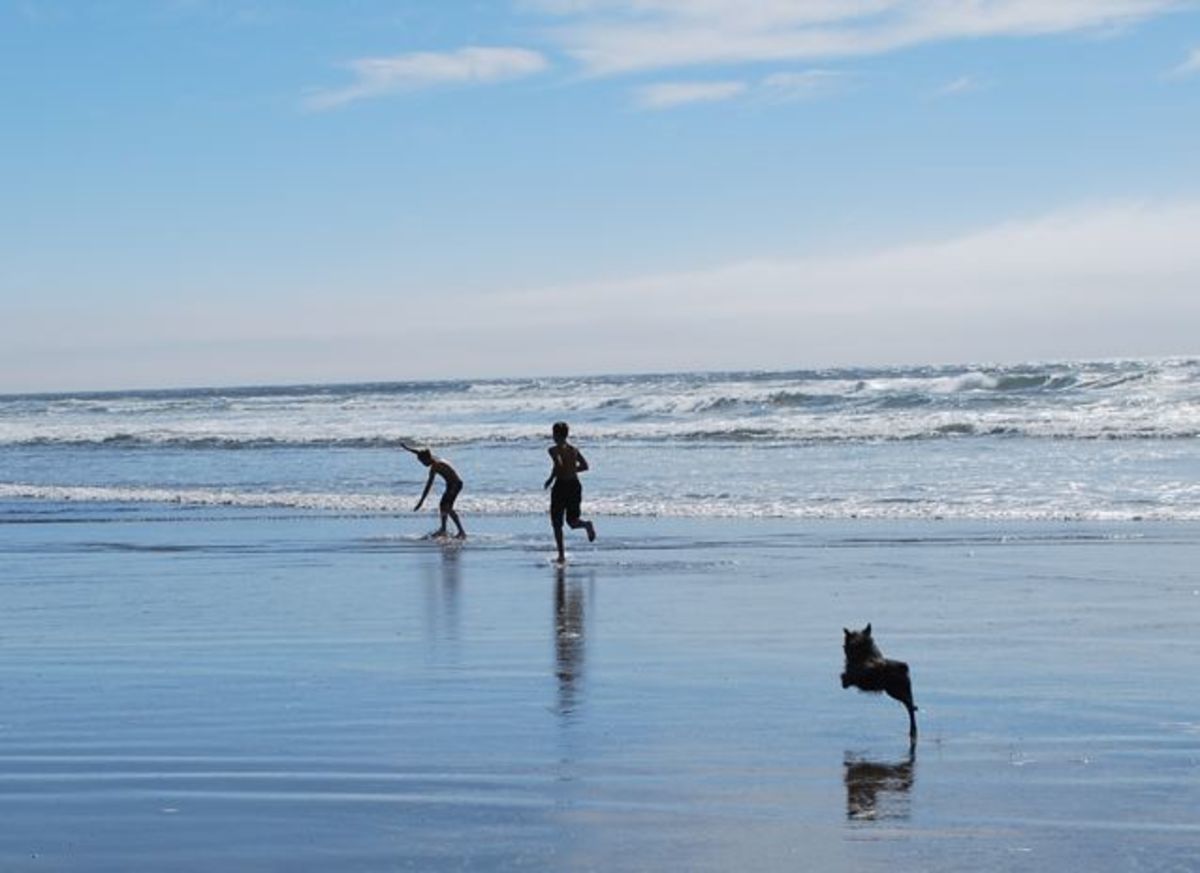- HubPages»
- Travel and Places»
- Visiting North America»
- United States
Oregon Badlands Wilderness Study Area
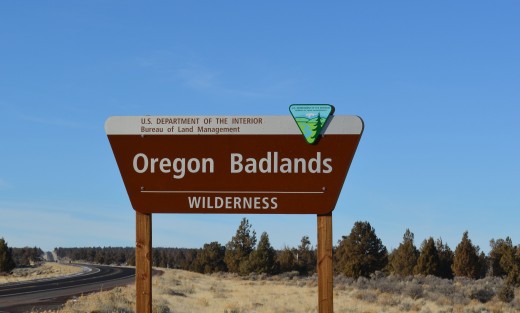
Badlands of Central Oregon
If you're looking for a place of solitude and peace, the Oregon Badlands Wilderness Study Area is the place to visit.
Situated less than 20 miles east of the bustling city of Bend, Oregon lies this vast incredibly desolate area known as the Badlands by locals.
Designated as a wilderness area as recently as 2009 by President Obama, it encompasses nearly 30,000 acres of old growth trees.
On a recent sunny and cold January day, the Oregon Badlands felt like the kind of place for a commune with nature and a great opportunity to capture some of the world's oldest trees.

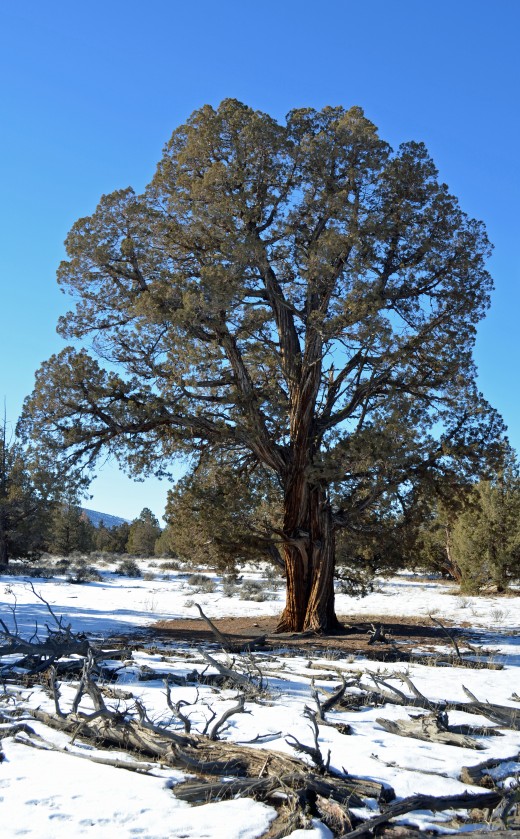
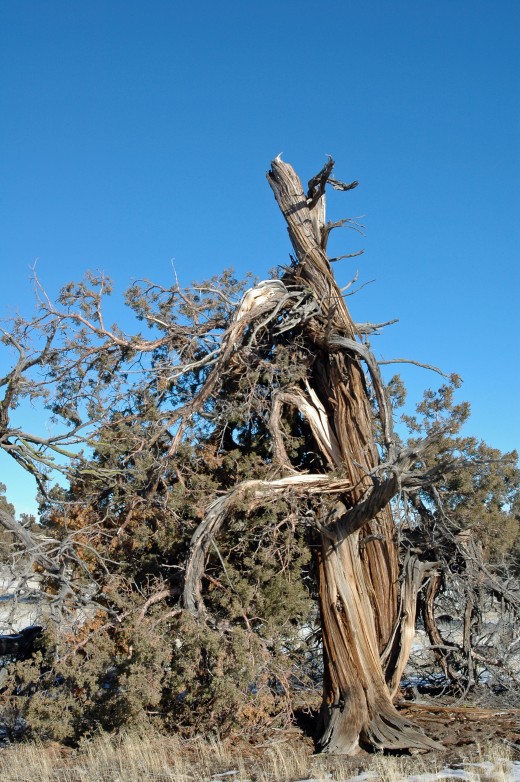
Badlands Old Growth Juniper Forest
Normally when people hear the term old-growth forest, they think of towering trees with a few rays of light interspersed glancing in from the high canopies of branches and leaves above.
Contrary to that picture, the Badlands Wilderness Study Area is not your typical old growth forest. However, don't be fooled. It's one of the oldest juniper forests in Oregon as well as the world.
On traversing the trails or even driving along the highways that border the WSA, one can find juniper trees of just about any age rooted in the sandy soil. The sandy ground covering is actually ash that traveled all the way from Crater Lake when Mt. Mazama blew thousands of years ago.
The old-growth juniper forests of Central Oregon are thought to be somewhere between 1000 and 1600 years old. Many ranchers and farmers throughout Oregon in general hate juniper trees because young trees can sap water tables of much needed sources of irrigation quickly. They seem to sprout up literally everywhere and as young trees, are rather spindly and thin.
However, as juniper trees grow, they subsist on roughly 9-14 inches of rainfall per year in this high mountain desert climate no matter what their size and how old they grow. Much like people in many cases, the older the junipers become, the more personality they assume.
Juniper trees come in many different looks. As the top photo illustrates, you'll see a fair share of beautifully symmetrical very tall trees with lush foliage (and thousands of juniper berries) dominating that part of the landscape fronted by broken branches or stumps.
For most folks, though, it's the older junipers that hold the story or trigger the photographer's shutter.
Older juniper trees are remarkable photo ops for their gnarled and broken bark. They may be completely devoid of leaves and replete with broken branches. They may have trunks that seem to be two trees when in fact it's just a twisting and turning of the bark latching on to itself to stay upright as it grows.
Trees are not close together in an old growth juniper forest but rather are spread out and form a rather isolative and lonely landscape.
Juniper trees at all stages in their lives provide homes for birds and small animals, shelter from storms that come up quickly in the desert climate, and even lush banquets for wintering robins and other berry-eating animals like the coyote.
Seemingly dead snags are still very much alive though they have lost their ability to grow leaves and now must subsist on extremely small amounts of water. They are part of the delicate desert ecosystem along with other scruffy specimens such as sagebrush, rabbit brush and various kinds of bunch grasses.
In springtime, the area abounds with color as the various wildflowers bloom.

Badlands WSA Facts
- Located 16-18 miles east of Bend (part of Department of Interior, under auspices of Bureau of Land Management)
- Encompasses almost 30,000 acres
- Spans two counties--Deschutes and Crook
- Elevation roughly a little less than 4000 feet
- Declared a wilderness area in 2009 by President Barack Obama
- No off-highway vehicles allowed
- No bicycles are allowed
- Horseback riding and hiking are allowed
- Camping is not allowed within the wilderness area
- All hikes are relatively flat and do not ascend more than 75 feet
- Trails are not well marked nor maintained--compasses and/or GPS are encouraged
- Rockhounding and hunting are not allowed (though permits for hunting are sometimes issued)
- Walking single file is not recommended especially when going off trail
- Disorientation is a common problem on the trails within the wilderness area
- Oregon Badlands WSA is 1 of 47 Oregon wilderness areas and 1 of 756 nationwide
See the video at the end of this article to hear about what makes the Oregon Badlands distinguishable as a wilderness area and what unique qualities it has.

Story of the Stumps
Part and parcel of the vast and rugged landscape of the Central Oregon Badlands Wilderness area is the number of stumps one can find.
Just as no two trees look alike in the Badlands, no two stumps look alike either. All are in a constant state of flux as nature works her magic on them.
Below, a stump that is very much alive with lichen.
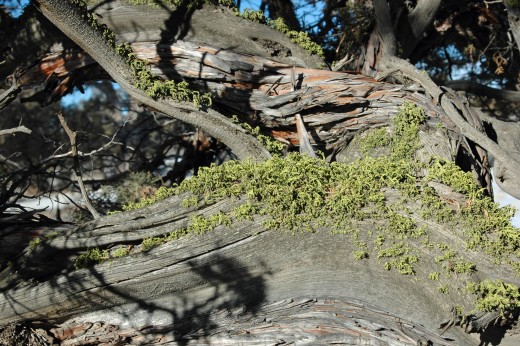
Another stump showing the sandy soil that covers the Badlands Wilderness Study Area. This soil makes it more difficult to see animal tracks and even the trail as with gusts of wind, the sand can move and erase what has been.
A great plus for hiking in snow in the Badlands area is that you can easily see animal tracks of many different species and see the footprints you made on the way in on the trail.
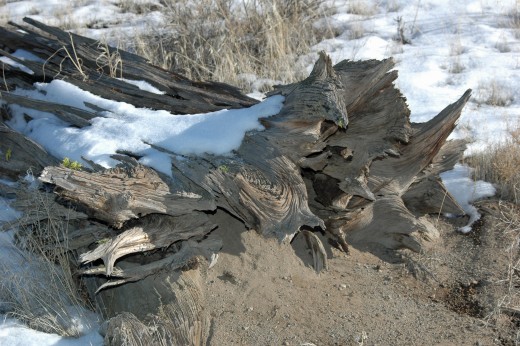
Snow, even a thin layer, brings the ground to life. It also lends interesting perspectives to the stumps for great photo opportunities.
This particular stump close up almost looks like several animal faces with their mouths open. This author could imagine a rabbit or another small animal face in the wood at the far right lower end of the stump and a badger on the one above it.
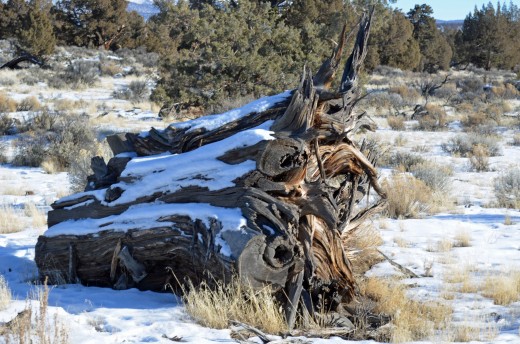
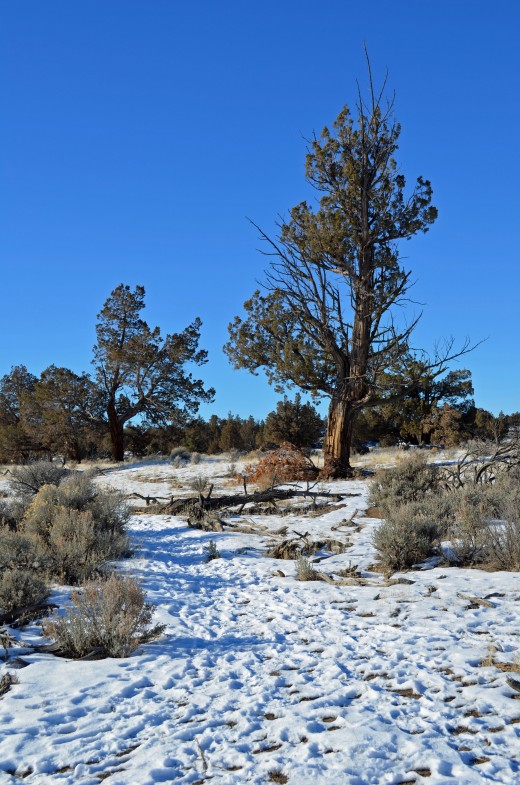
Trails in Oregon Badlands
In an effort to preserve the Wilderness Study Area, there is little evidence of manmade convenience. At the trailhead for the trails pictured below, there was no bathroom, no brochures, and no trashcans.
That being said, everything you pack into the wilderness area should in this author's opinion be packed back out. Since dogs are allowed on leash in the Badlands, we took two of our malamutes.
As our luck would have it, we had a dog waste event of the largest kind to clean up. Another hiker passed this author on the trail and expounded that it really was unnecessary to clean it up (bag it) in this area. However, being a responsible dog owner, we packed it back out to another spot that had a trashcan.
The trails as mentioned above are not particularly well marked at all and it is very easy to become disoriented especially if you don't have a good sense of direction. The best bet is to keep landmarks in sight if at all possible. In this case, we knew that the Cascades were to our left (or west) and our car was behind us (to the south).
I recently read an account of a fellow who took his 6-year-old boy for a "hike" in the Badlands and ended up so lost that they had to thrash through the brush to finally get out to Highway 20 and then had to walk many miles to get back to their car. While it had a happy ending, it could have been a bad experience for both.
The trails have very little incline as the picture notes. There are mostly trees but there are some rock formations as this is volcanic territory, home to a very large shield volcano (a rather long, flat type of volcano).
Print off a map from the Bureau of Land Management site before setting out.
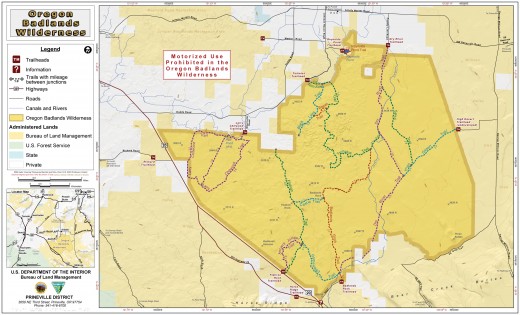

Badlands Dry River Trail
For whatever reason we selected this trail, it was a good trail and we had no problem finding our way back out. We did not go to the end of the trail and still managed to hike for several hours. The ground was strewn with rocks mostly buried in the soil and the walk was not strenuous. However, even in the winter, the sun can be extremely warm and you definitely can work up a sweat no matter what season.
Some of the other most popular trails:
Badlands Rock Trail
- Hike or horseback ride--in and out
- 6.0 miles round trip
- Elevation gain/loss is 75 feet
- Trailhead access 17.9 miles east on Highway 20--see BLM site for more details
This trail affords a 360-degree view of Central Oregon. There are also 2 longer loop options accessible via the Castle Trail (7.7 miles) or the Tumulus Trail (12.3 miles)--you can use either to return to the trailhead.
Flatiron Rock Trail
- Horseback ride or hike--in and out trail
- Also has shorter looping options
- Elevation gain/loss is 60 feet
- Trail access--Flatiron Trailhead 16 miles east of Bend on Highway 20--trailers not advised
Skirts the shield volcano and takes you to an unusual rock formation called Flatiron. There is an oblong moat here as well. The trail goes to the north boundary of the Badlands.
Tumulus Trail
- Horseback ride or hike--in and out trail
- 5.0 to 15.0 miles round trip--dependent on route--shorter loops available
- Elevation gain/loss is 75 feet
- Sound navigational skills recommended--easy to get lost
- Trailers not advised
Trailhead is located off Alfalfa Market Road on Johnson Ranch Road near the transfer station.
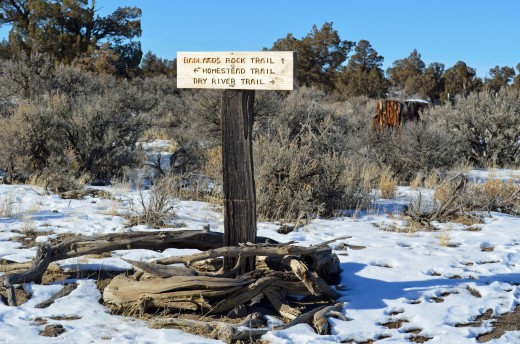
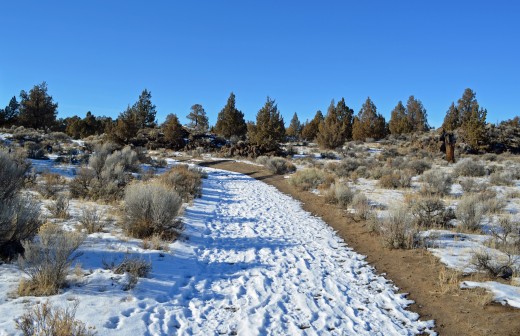
Veering from the trails is perfectly acceptable in the Badlands Wilderness Study Area. But have a care. It's recommended that hikers and horses NOT walk in single file on trails and off the trails but rather abreast.
This minimizes the impact on the environment and preserves the natural landscape. (It also coincidentally makes trails harder to follow but it's an ecologically sound preference)
Also mud and snow can make the trails impassable for vehicles so use best judgment when driving in whether it's with cars or horse trailers.
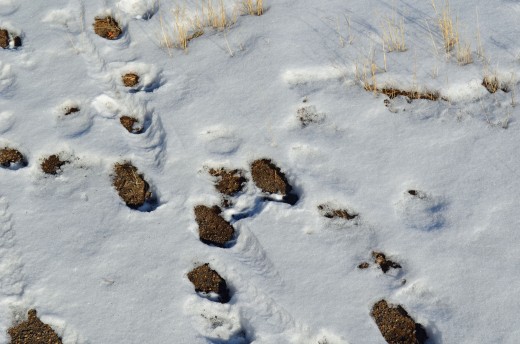
The magic of the trees is worth the trip. You can go on innumerable trails throughout the Oregon Badlands and never see a tree that looks exactly the same as another.
Check out some of the names given to these magnificently photogenic trees by other photographers and nature buffs over the years. (see caption below photos)
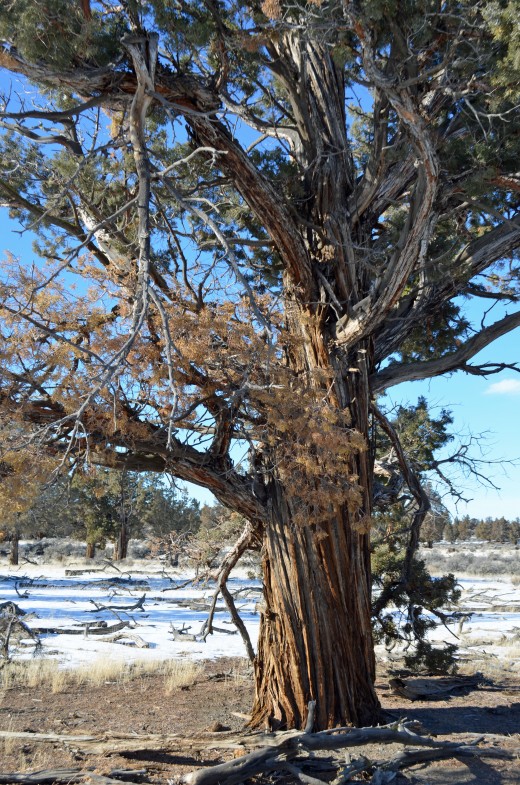
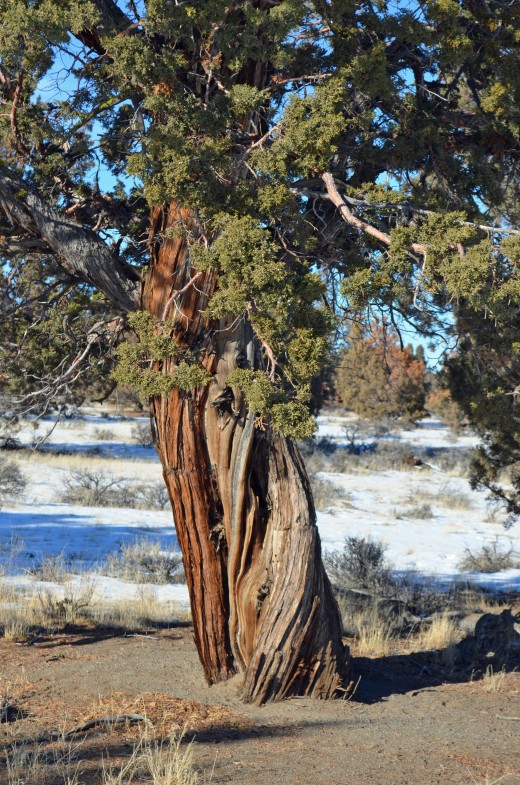
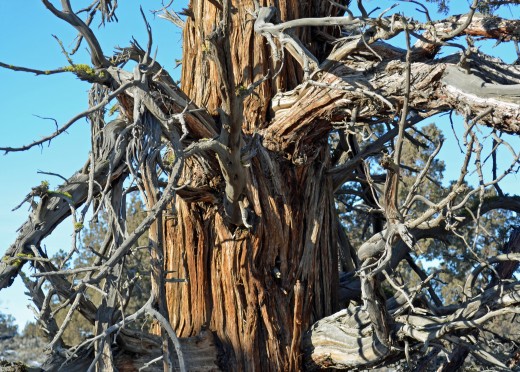
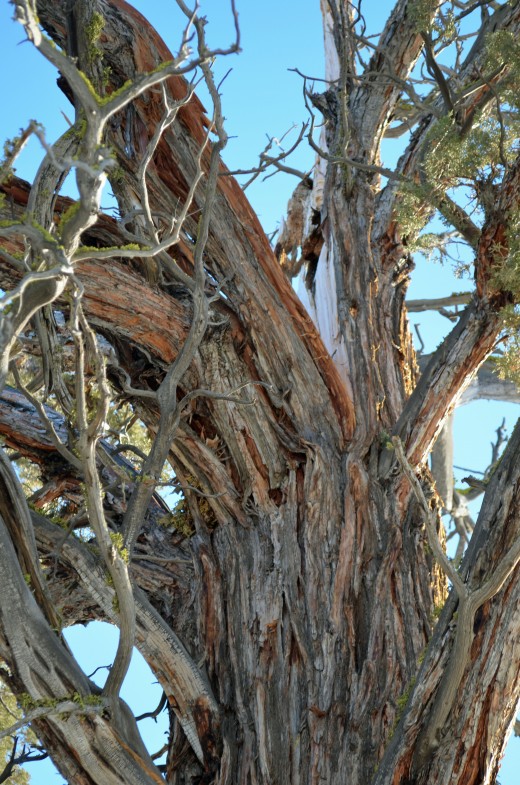
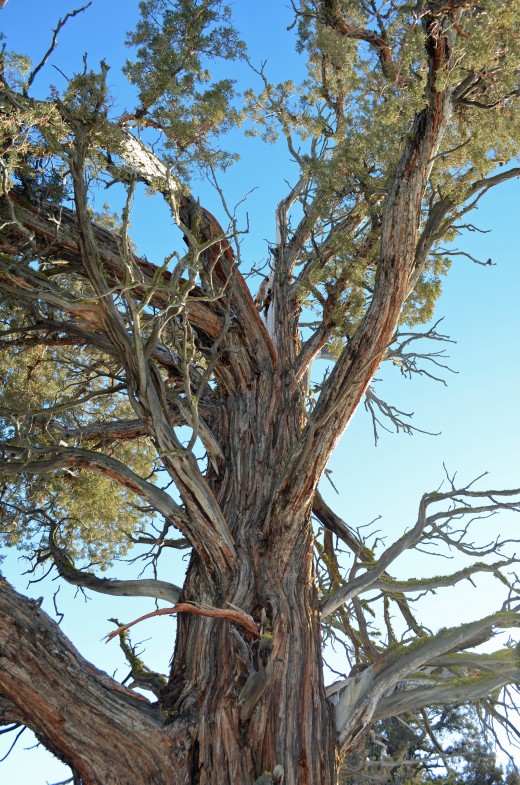
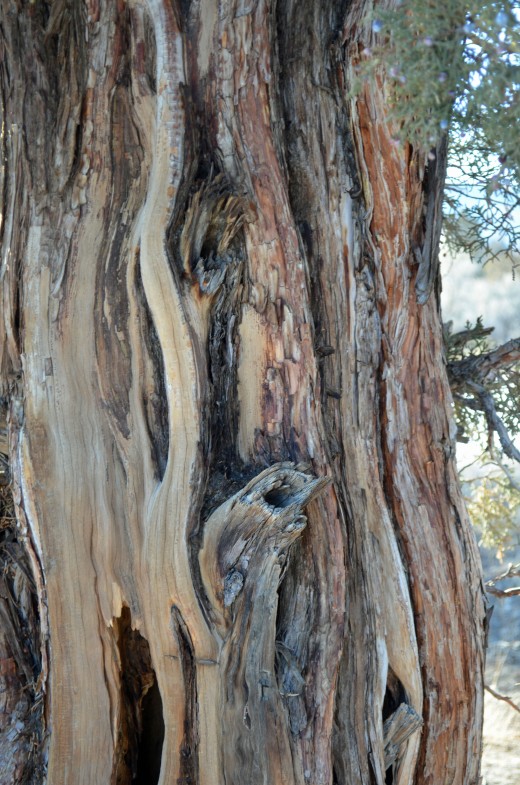
Peace and Serenity of the Forest
The Badlands is not a place where you will usually see lots of people on any given day, although it is a great place for birders and nature groups to explore.
Most people go to hike or jog--away from the madness of city life--or take a stroll with a backpack and camera (and sometimes their trusted dogs).
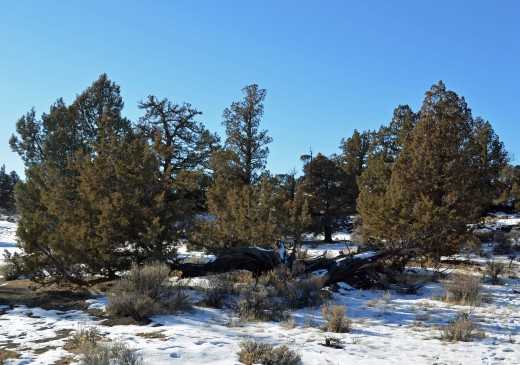
Dogs and the Badlands Wilderness Study Area
This author would advise being cautious about taking your dogs into the Wilderness Study Area especially on hot, warm days. We felt very confident taking our two malamutes because there was still snow on the ground.
However, dogs are a nuisance to wildlife in general, especially off leash. This author did see other people with their dogs off leash which is always a personal concern. Should dogs take off after something in the wilderness area, it might be a task pinpointing where you last saw them and/or knowing the things in the wilderness, would their safety be assured?
This author strongly believes in the sanctity of wilderness. We are merely observers and should treat our walk through as stepping lightly on sacred ground. The wilderness should not literally feel our footprint. Likewise, our dogs should be obedient and on leash at all times so as not to disturb the animals and the fragile ecosystem of something as awe-inspiring as an old growth forest.
As a precautionary measure, personally, I would worry about rattlesnakes in the height of the blistering desert summers. While there are no alarming reports of rattlers in this particular region, more and more are turning up unexpectedly where people think they won't see them in Central Oregon.
Especially with pets, caution should be exercised as time is of the essence in terms of getting emergency treatment for rattlesnake bites.
Above all, make sure your pet has ample water. Carry water for both humans and canines and a portable water dog bowl is a handy tool and weighs nothing.
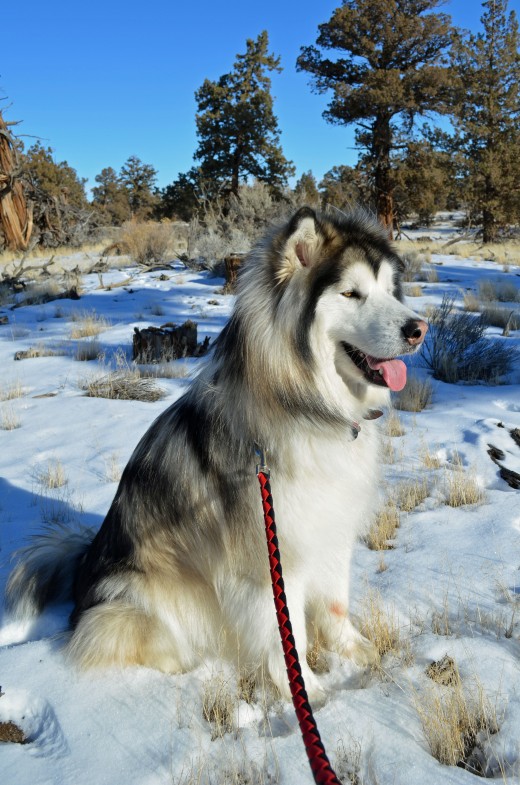
What to Take to the Badlands WSA
- Select clothing appropriate to the weather but check the forecast--weather can be very unpredictable on the high mountain desert
- Hiking boots preferred or at least closed toed shoes
- Compass and/or GPS
- Cell phone though you might not get service--remember to tell someone where you are going and when you will be returning
- Backpack with water, handkerchief and snacks--more if you have dogs
- Dog waste bags
- Camera
- Leash for dog
- Hat, gloves, sunscreen, sunglasses depending upon weather
- Common sense--be aware of your surroundings and make note of what trails you take, what direction you go in

Wildlife in the Badlands
On any given day, you might see:
- Black tailed jack rabbits
- Mule deer
- Elk
- Pronghorn (antelope)
- Cottontail rabbits
- Bats
- Coyotes
- Lizards (6 species reside)
- Snakes (bull snakes and presumbly rattlesnakes)
- More than 100 species of birds--like golden eagles, sage grouse and prairie falcons
- Bobcats

Getting to the Badlands Wilderness Area
Badlands Renewal Project
Thanks to Friends of the Badlands, the Oregon Badlands has a chance at survival for eternity. It's important to understand the history of this beautiful wilderness area and the significance of its presence in our world.






